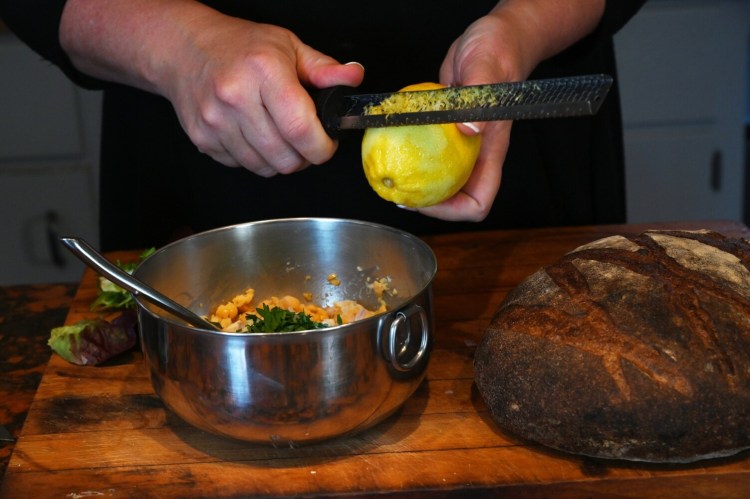When they were little, my kids clamored for any Laura Numeroff “If You Give …” books. After all, if you give a mouse a cookie, a moose a muffin, or a pig a pancake, unexpected things happen, and hilarity ensues. As a parent, I appreciated the way Numeroff’s words and collaborator Felicia Bond’s pictures clearly illustrate how practicing a little hospitality can make life very interesting.
I am a firm believer in the power of hospitality as a change agent. Inviting someone to a meal can make their day, make clogged communication pathways flow and make connections last. But a new global campaign called DefaultVeg is now promoting hospitality as a means of addressing climate change.
The idea is a simple one. When you build a menu for any gathering – whether that be New Year’s brunch with the family, a small lunch meeting in a workplace conference room, or a catered event for 200 – feature plant-based or plant-forward meals as the default option, giving diners the choice to add or opt into meat and/or dairy items upon request.
Research compiled by the campaign’s organizers – the Better Food Foundation in the United States and CreatureKind and the U.K. Food plan in Europe — shows that by just changing the default, consumers are much more likely to choose a plant-based meal.
The campaign is grounded in the tenet that consuming less meat and dairy is one of the most effective ways individuals can reduce their carbon footprint. The recently published DefaultVeg Resource Guide (available at defaultveg.com) points to many studies that show if consumers demand more plant-based meals, consumer demand would drive commercial farmers around the world to raise plants rather than animals. One study published last February in the academic journal Science and based on data collected from 40,000 farms in 113 countries says a large-scale switch to plant-based diets could reduce farmland usage worldwide by 75 percent – an area equivalent to the U.S., China, European Union and Australia combined. Of course, for this reduction to factor into the fight against climate change, the land would have to remain undeveloped.
In discussing the psychology involved in the DefaultVeg scheme, organizers say defaults can have a powerful effect on individual and group behavior because humans tend to go with the status quo, since opting in or out of a condition requires more time and effort. One example of the power of defaults comes from organ donation. Countries where action is needed to opt into donating organs have donation rates as low as 15 percent. Yet countries where action is needed to opt out of donation have rates as high as 90 percent. Another example lies in retirement savings. When companies automatically enrolled employees in savings plans upon hire (unless they opted out), new employee participation shot up by 25 percent.
The DefaultVeg Resource Guide references a Harvard School of Public Health field experiment that tested the effects of defaults on meat consumption. The control group was presented with a meat option as the default, and the experimental group was presented with a vegetarian option as the default. When the default meal was changed from meat to vegetarian, the percentage of people who ate meat dropped from 67.4 to 24.4 percent.
DefaultVeg organizers say their own research shows that that if you serve 1,000 plant-based meals, your carbon savings would be the same as not driving your car 4,141 miles or changing the lighting in 60 rooms to energy efficient bulbs. The guide is chockablock with strategies for institutional dining services, catering managers, event planners and home cooks to create DefaultVeg menus for their diners (a few recipes include cheese or mayonnaise), execute their delivery to table, and celebrate the food on the plate as simply delicious instead of merely lacking meat. After all, if you give an omnivore a vegan sandwich, chances are they are going to eat it.
CHRISTINE BURNS RUDALEVIGE is a food writer, recipe developer and tester, and cooking teacher in Brunswick, and the author of “Green Plate Special,” a cookbook from Islandport based on these columns. She can be contacted at cburns1227@gmail.com.

Can a chickpea salad sandwich save the planet? Shawn Patrick Ouellette/Staff Photographer Buy this Photo
Chickpea Salad Sandwiches
With the herbs and spices included in these sandwiches, your eaters won’t miss the tuna or chicken they are used to having between the slices of bread.
Makes 2 sandwiches
1 (15-ounce) can chickpeas or 1-1/2 cups cooked chickpeas
1/2 cup diced fennel or celery
1/4 cup finely chopped shallot
3 tablespoons vegan mayonnaise or cashew cream
1 teaspoon lemon zest
1 tablespoon lemon juice
1 teaspoon cumin seeds, toasted and crushed
1/4 cup chopped soft herbs, such as parsley, cilantro, chives or chervil
Kosher salt and freshly ground pepper
4 slices bread
Lettuce, spring green mix, or sprouts
Drain and rinse the chickpeas. In a medium bowl, smash the chickpeas with a fork. Add the fennel, shallots, mayonnaise, lemon zest and juice, cumin seed and chopped herbs, and stir well to combine. Add salt and pepper to taste. If the salad is dry, add more mayonnaise (cooked chickpeas are drier than canned).
Assemble the sandwiches and serve, or wrap them up (preferably in beeswax wrap) as required for packed lunches.
Send questions/comments to the editors.


